

 The main keying device at K2CD is a Bencher BY-2 iambic paddle. The vast majority of my DX on CW was worked with this key. I bought this key in 1991 just prior to earning my General Class ticket. It's been chugging along ever since.
The main keying device at K2CD is a Bencher BY-2 iambic paddle. The vast majority of my DX on CW was worked with this key. I bought this key in 1991 just prior to earning my General Class ticket. It's been chugging along ever since.Click to hear what an iambic keyer and Paddles sounds like. (65k .wav)
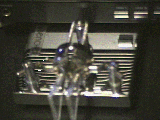 Another view of the Bencher BY-2. Notice the interesting effect as one of the speakers is reflected in the highly polished chrome base. The XYL captured this image.
Another view of the Bencher BY-2. Notice the interesting effect as one of the speakers is reflected in the highly polished chrome base. The XYL captured this image.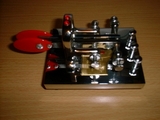 This is probably the most nostalgic looking paddle out on the market today. The Vibroplex Deluxe iambic is styled along the lines of their historic semi-automatic keys. This little gem is a joy to own, and operate. Red finger pieces, jeweled pivots, and gleaming chrome along with a brass name plate. What more can one ask for?
This is probably the most nostalgic looking paddle out on the market today. The Vibroplex Deluxe iambic is styled along the lines of their historic semi-automatic keys. This little gem is a joy to own, and operate. Red finger pieces, jeweled pivots, and gleaming chrome along with a brass name plate. What more can one ask for?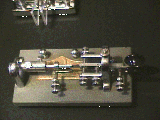 For some time now, I've been having a "Love Hate affair" with bugs. I love to collect them, but I hate the way some of them sound on the air. This Vibroplex Standard is the first bug I picked up. It has a rather unremarkable feel, and took alot of getting used to. I mainly use the bugs to ragchew with, usually when I hear someone else calling CQ using one.
For some time now, I've been having a "Love Hate affair" with bugs. I love to collect them, but I hate the way some of them sound on the air. This Vibroplex Standard is the first bug I picked up. It has a rather unremarkable feel, and took alot of getting used to. I mainly use the bugs to ragchew with, usually when I hear someone else calling CQ using one. Click to hear what a Bug Key sounds like. (88k .wav)
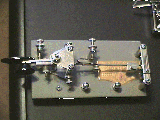 Here's another of the classic Vibroplex models- A Lightning Bug. It's mounted on the standard gray base. I had to destroy a good microphone to acquire this bug. I was attempting to open up a Kenwood MC-60A mic with Visegrips and Channel lock pliers. My intent was to install a Heil element in the mic. Well the pliers slipped causing the ugliest gouge you could imagine on the barrel of the mic. A local ham who is not into aesthetics swapped me the bug for the mic. I got rid of an eyesore and gained a classic bug. I still miss the MC-60A though. There's a lesson here I think.
Here's another of the classic Vibroplex models- A Lightning Bug. It's mounted on the standard gray base. I had to destroy a good microphone to acquire this bug. I was attempting to open up a Kenwood MC-60A mic with Visegrips and Channel lock pliers. My intent was to install a Heil element in the mic. Well the pliers slipped causing the ugliest gouge you could imagine on the barrel of the mic. A local ham who is not into aesthetics swapped me the bug for the mic. I got rid of an eyesore and gained a classic bug. I still miss the MC-60A though. There's a lesson here I think.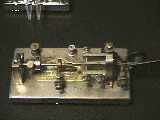 Now here is a bug just oozing with history! This 1920`s circa Vibroplex standard on a nickle plated base belonged to a local ham "Griff" Griffin, W2LOR, and was purchased new by him in the 1920`s! I acquired the bug from a friend, and cleaned it up, and amazingly it still works fairly well. The springs are pretty worn out making it only good to about 20 WPM downhill! Sadly, Griff recently became a Silent Key. I like to think that a part of him still lives on within this bug. I am honored to have known Griff, and to be the custodian of this piece of ham radio history.
Now here is a bug just oozing with history! This 1920`s circa Vibroplex standard on a nickle plated base belonged to a local ham "Griff" Griffin, W2LOR, and was purchased new by him in the 1920`s! I acquired the bug from a friend, and cleaned it up, and amazingly it still works fairly well. The springs are pretty worn out making it only good to about 20 WPM downhill! Sadly, Griff recently became a Silent Key. I like to think that a part of him still lives on within this bug. I am honored to have known Griff, and to be the custodian of this piece of ham radio history.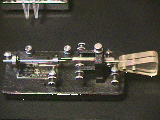 Last but certainly not least is my favorite bug of all. It's an E.F. Johnson Speed-X on a black 3 inch base. This is by far the smoothest bug I've used, and the most adjustable. Of all my bugs, this is the one I take into an occassional DX pileup. It just feels better than the Vibroplexes for some reason. The finger pieces on this one are not original. They were formed from thick plexi-glass stock. Perhaps the added thickness adds to the controlability of this bug?
Last but certainly not least is my favorite bug of all. It's an E.F. Johnson Speed-X on a black 3 inch base. This is by far the smoothest bug I've used, and the most adjustable. Of all my bugs, this is the one I take into an occassional DX pileup. It just feels better than the Vibroplexes for some reason. The finger pieces on this one are not original. They were formed from thick plexi-glass stock. Perhaps the added thickness adds to the controlability of this bug?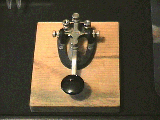 What Ham station is complete without a straight key? How else could one join in the fun every Dec 31, during SKN? This J-38 knock-off is another Speed-X product, but from the Nye Viking Company. It's as simple as one can get. Mount it on a block of wood, wire up a plug, and off you go. I made my first shaky CW QSO on a similar straight key. Will this one be a classic some day?
What Ham station is complete without a straight key? How else could one join in the fun every Dec 31, during SKN? This J-38 knock-off is another Speed-X product, but from the Nye Viking Company. It's as simple as one can get. Mount it on a block of wood, wire up a plug, and off you go. I made my first shaky CW QSO on a similar straight key. Will this one be a classic some day? Click to hear what a Straight Key sounds like. (86k .wav)
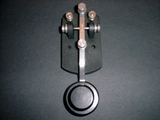 Here's another fine straight key which I acquired at a local flea market. It's yet another Speed-X, this one with a heavy duty lever arm, and sexy Navy knob. It was mounted on a heavy piece of wood, and wired with cotton and rubber insulated line cord to a light bulb socket. This in turn went to another old piece of line cord which terminated in an AC socket plug! You were expected to plug this into the nearest outlet, screw in a light bulb, and send Morse by light. I suspect that rather than learn Morse, the poor guy who was Elmered with this key had the Daylights shocked out of him in short order. What a hearty breed the hams of yesteryear must have been!
Here's another fine straight key which I acquired at a local flea market. It's yet another Speed-X, this one with a heavy duty lever arm, and sexy Navy knob. It was mounted on a heavy piece of wood, and wired with cotton and rubber insulated line cord to a light bulb socket. This in turn went to another old piece of line cord which terminated in an AC socket plug! You were expected to plug this into the nearest outlet, screw in a light bulb, and send Morse by light. I suspect that rather than learn Morse, the poor guy who was Elmered with this key had the Daylights shocked out of him in short order. What a hearty breed the hams of yesteryear must have been!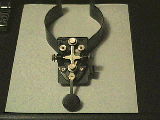 This interesting straight key is a J-45, and was made for military use. This particular specimen was manufactured by the Winslow Company. You can see by the photo that it was meant to be clamped onto the operator's leg to keep it place while operating mobile. To me it seems more like a medieval torture device, because soon after I tried it on my leg, the circulation was cut off and I was hopping around trying to get the feeling in my leg back. I had hoped to use it while operating from the mobile, but wouldn't be able to operate the pedals with my leg asleep. It's still a neat key, though. . .
This interesting straight key is a J-45, and was made for military use. This particular specimen was manufactured by the Winslow Company. You can see by the photo that it was meant to be clamped onto the operator's leg to keep it place while operating mobile. To me it seems more like a medieval torture device, because soon after I tried it on my leg, the circulation was cut off and I was hopping around trying to get the feeling in my leg back. I had hoped to use it while operating from the mobile, but wouldn't be able to operate the pedals with my leg asleep. It's still a neat key, though. . .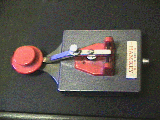 Finally, here's another straight key, this one from the Ham-Key Company. I can't resist a key of any persuasion, even a relatively "cheap" one like this. They also made a paddle styled the same way. I remember seeing in the 70's a combination straight key and paddle on the same base from this company. Sure wish I had one of those.
Finally, here's another straight key, this one from the Ham-Key Company. I can't resist a key of any persuasion, even a relatively "cheap" one like this. They also made a paddle styled the same way. I remember seeing in the 70's a combination straight key and paddle on the same base from this company. Sure wish I had one of those. Here's my first attempt at home brewing paddles. The idea just occurred to me one day despite my lack of talent. I came up with very nice feeling paddles. I can send as fast and accurately as with my Bencher. Its sum of parts consists of 2 pieces of wood, 1 hacksaw blade, 2 wood screws, 3 machine screws, and a few washers, and nuts. The fingerpieces were cut off the handles of a "swing-away" can opener (much to my XYL's dismay!) These are great "knock around" paddles for taking up on the hill. If they accidently fall on the pavement from the tailgate- big deal. Don't try that with a gleaming chrome Bencher!
Here's my first attempt at home brewing paddles. The idea just occurred to me one day despite my lack of talent. I came up with very nice feeling paddles. I can send as fast and accurately as with my Bencher. Its sum of parts consists of 2 pieces of wood, 1 hacksaw blade, 2 wood screws, 3 machine screws, and a few washers, and nuts. The fingerpieces were cut off the handles of a "swing-away" can opener (much to my XYL's dismay!) These are great "knock around" paddles for taking up on the hill. If they accidently fall on the pavement from the tailgate- big deal. Don't try that with a gleaming chrome Bencher!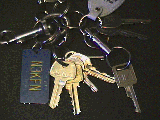 Ha Ha Ha, at least you can never accuse me of not being thorough. These keys complete the key line-up at K2CD. Hope you enjoyed seeing them!
Ha Ha Ha, at least you can never accuse me of not being thorough. These keys complete the key line-up at K2CD. Hope you enjoyed seeing them! Click to hear what My Keys sounds like. (35k .wav)

Back to GeoCities Cape Canaveral